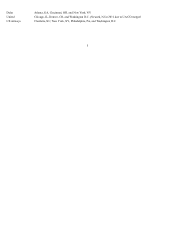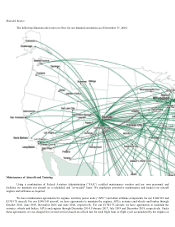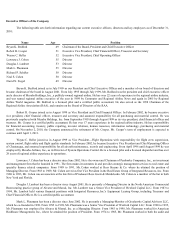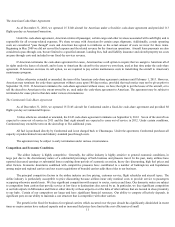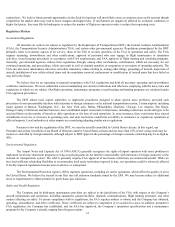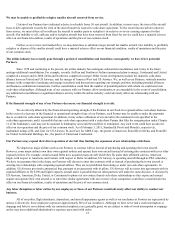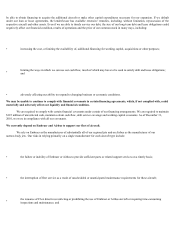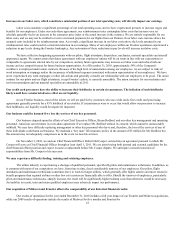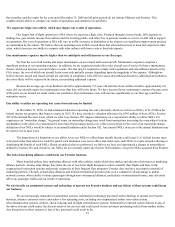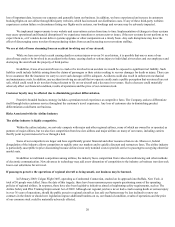Frontier Airlines 2010 Annual Report Download - page 19
Download and view the complete annual report
Please find page 19 of the 2010 Frontier Airlines annual report below. You can navigate through the pages in the report by either clicking on the pages listed below, or by using the keyword search tool below to find specific information within the annual report.inspections to major overhauls. The FAA, acting through its own powers or through the appropriate U.S. Attorney, also has the power to
bring proceedings for the imposition and collection of fines for violation of the Federal Aviation Regulations.
The Company is subject to various other federal, state, and local laws and regulations relating to occupational safety and health,
including Occupational Safety and Health Administration and Food and Drug Administration regulations.
Security Regulation
Pursuant to the Aviation and Transportation Security Act (the “Aviation Security Act”), the TSA, a division of the U.S. Department
of Homeland Security, is responsible for certain civil aviation security matters. The Aviation Security Act addresses procedures for, among
other things, flight deck security, the use of federal air marshals onboard flights, airport perimeter access security, airline crew security
training, security screening of passengers, baggage, cargo, mail, employees, and vendors, training and qualifications of security screening
personnel, provision of passenger data to U.S. Customs and Border Protection, and background checks. Under the Aviation Security Act,
substantially all security screeners at airports are federal employees, and significant other elements of airline and airport security are overseen
and performed by federal employees, including federal security managers, federal law enforcement officers, and federal air marshals.
TSA-mandated security procedures can have a negative effect on the Customer experience and the Company’ s operations. For
example, in 2006, the TSA implemented security measures regulating the types of liquid items that can be carried onboard aircraft. In 2009,
the TSA introduced its Secure Flight Initiative. As part of that initiative, the Company has begun collecting additional Customer data. The
Secure Flight Initiative was created to help reduce the number of passengers who are misidentified as possible terrorists because their names
are similar to those of people on security watch lists. The program standardized how names are matched, as well as added age and gender to a
passenger’ s profile. Under the program, the Company is required to ask for Customer names exactly as they appear on a government-issued
photo ID such as a passport or driver’ s license. In addition, the Company must ask Customers for their gender and date of birth. The TSA has
also indicated its intent to expand its use of whole body imaging machines around the United States.
The Company has made significant investments to address the effect of security regulations, including investments in facilities,
equipment, and technology to process Customers efficiently and restore the airport experience; however, the Company is not able to predict
the ongoing impact, if any, that various security measures will have on Passenger revenues and the Company’ s costs, both in the short-term
and the long-term.
Additional Information
The Company files annual, quarterly and current reports and other information with the SEC. These materials can be inspected and
copied at the SEC's Public Reference Room at 450 Fifth Street, N.W., Washington, D.C. 20549. Copies of these materials may also be
obtained by mail at prescribed rates from the SEC's Public Reference Room at the above address. Information about the Public Reference
Room can be obtained by calling the SEC at 1-800-SEC-0330. The SEC also maintains an Internet site that contains reports, proxy and
information statements, and other information regarding issuers that file electronically with the SEC. The address of the SEC's Internet site is
www.sec.gov.
On our website, www.rjet.com/investorrelations.html, we provide free of charge our Annual Report on Form 10-K, Quarterly
Reports on Form 10-Q and Current Reports on Form 8-K as soon as reasonably practicable after they have been electronically filed or
furnished to the Securities and Exchange Commission. The code of ethics, adopted by our Board of Directors, which applies to all our
employees, can also be found on our website, www.rjet.com/investorrelations.html. Our audit committee charter is also available on our
website.
ITEM 1A. RISK FACTORS
The following risk factors, in addition to the information discussed elsewhere herein, should be carefully considered in evaluating us
and our business:
Risks Related To Our Operations
We are vulnerable to increases in aircraft fuel costs.
High oil prices may have a significant adverse impact on the future results of operations. We cannot predict the future cost and
availability of fuel, or the impact of disruptions in oil supplies or refinery productivity based on natural disasters, which would affect our
ability to compete. The unavailability of adequate fuel supplies could have an adverse effect on our


